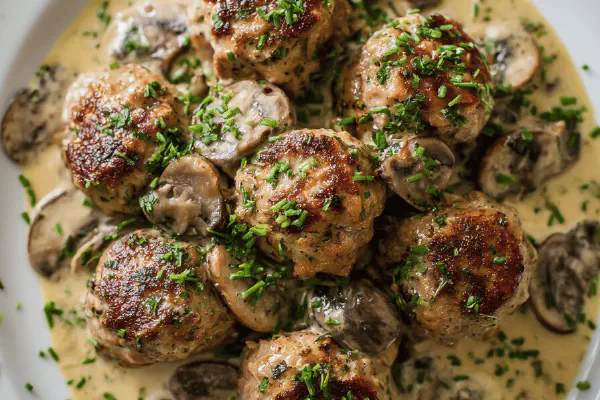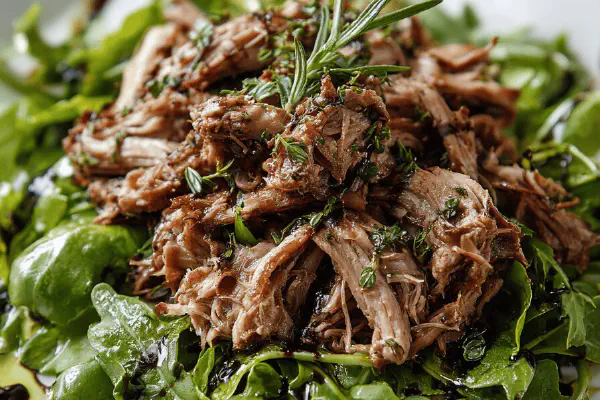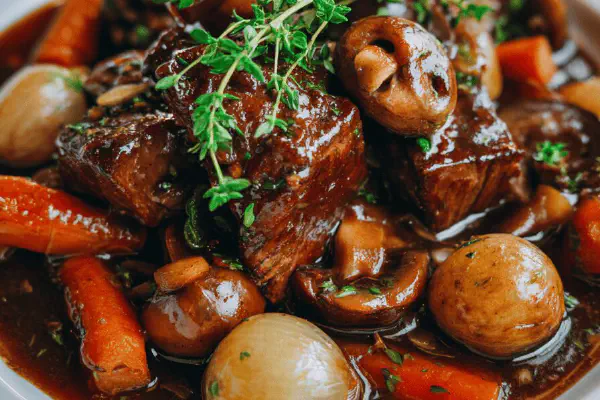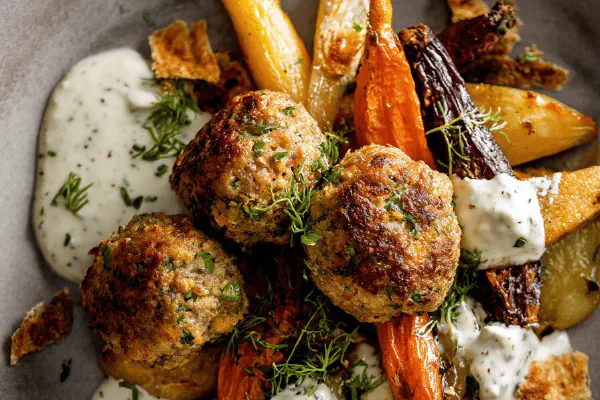Pork Rib Roast with Mushroom Sauce
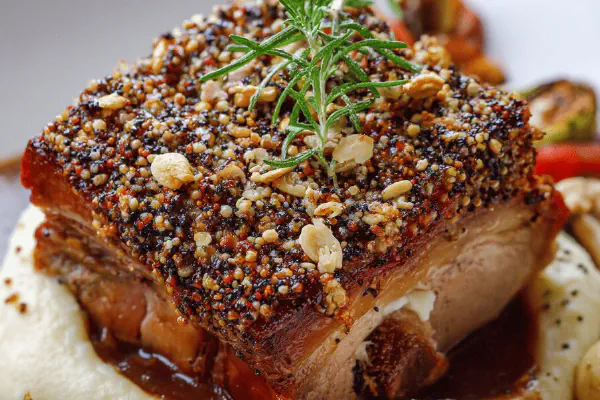
By Emma
Certified Culinary Professional
Ingredients
- 7 ml (1 ¼ tsp) cracked black peppercorns
- 8 ml (1 ⅓ tsp) crushed fennel seeds
- 1 pork rib roast with 6 ribs, about 1.75 kg (3 ¾ lb)
- Salt and coarse ground black pepper
- For mushroom sauce
- 50 ml (3 tbsp plus 1 tsp) unsalted butter, divided
- 25 ml (1 ½ tbsp) all-purpose flour
- 5 garlic cloves, minced finely
- 1 bottle (341 ml) amber ale or substitute with a mild lager
- 900 ml (3 ¾ cups) chicken broth, low sodium
- 40 ml (2 ⅔ tbsp) molasses or substitute with honey for a lighter finish
- 200 g (7 oz) white button mushrooms, chopped
About the ingredients
Method
Pork rib roast
- Preheat oven to 205 °C (400 °F) with rack centered. Mix pepper and fennel seeds coarsely in a plate. Coat pork all over, patting spices to stick. Season with salt liberally on all sides.
- Heat a large ovenproof skillet over medium-high. Add a splash oil. Sear pork, pressing down to color evenly, all sides about 2-3 minutes each. Look for golden crust forming; don’t rush or meat won’t hold juices.
- Transfer skillet to oven. Roast about 1 hour 10 minutes, checking early at 1 hour with a meat thermometer inserted deep (avoid bone). Meat should read 56 °C (133 °F) for medium-rare, adjust time if larger or smaller.
- Remove from oven, tent loosely with foil. Internal heat will rise to 62 °C (144 °F) over 10 minutes resting. Resting crucial: juices redistribute rather than running out the moment you cut.
Mushroom sauce
- While pork roasts, melt half the butter in a medium saucepan over medium heat. Add flour and garlic; stir constantly until roux smells nutty and light golden — about 3-4 minutes. Don’t brown too much, or garlic burns bitter.
- Gradually whisk in beer, scraping bottom to dissolve brown bits. Bring to boil; watch for foam and bubbling; reduces by half, thickens, about 16-17 minutes. Beer choice affects depth; amber or red ales bring maltiness; lagers yield cleaner flavor.
- Pour in chicken broth and molasses. Return to boil, stirring occasionally. Reduction here concentrates flavors; if sauce too thin near end, increase heat briefly but watch closely or it scorches.
- Separately, heat remaining butter in skillet on medium-high. Add mushrooms, salt, and pepper. Sauté until mushrooms lose moisture and edges brown, about 7 minutes. Adds caramelized complexity not achieved by cooking in sauce.
- Stir mushrooms into sauce, adjust seasoning. Keep warm, stir occasionally to prevent skin forming. Sauce thickens as it rests.
- Slice pork against grain evenly, arrange on platter. Spoon hot mushroom sauce over slices. Recommend sides: roasted carrots with thyme and creamy mashed potatoes — balance rich meat and sauce.
===
- Common issues: under-roasting leaves pork chewy, overcooking makes dry. Use instant read thermometer, watching color cues (crust shiny and crackling with spices). Sauce too thin? Mash a small raw mushroom in sauce; natural starch helps. Sauce too thick? Warm broth or water, little by little.
- Substitution tips: fennel can swap with star anise but use sparingly, flavor dominates. Beer replaced by dry cider or light wine but changes base character. Molasses optional; honey softens bitterness but reduces depth.
- Efficiency hacks: Dice mushrooms while meat roasts to save time. Use oven-safe pan for searing to avoid transfer trauma and heat loss. Keep all mise en place laid out—garlic minced, butter measured—keeps sauce smooth.
- Sensory cues: hear sizzle bursts during searing, smell spice crust forming, see sauce thicken to coating consistency, mushrooms glossy and browned, pork with juicy faint pink center. Texture crucial—poke tender but firm. Remove immediately from heat once done; carryover cooking continues.
- Experience taught me—don’t skip resting meat. Early versions I cut immediately, lost all juice to platter—dry disaster. Sauce deepens if given 5 minutes rest off heat; flavors fuse, no need to fuss later. Simple components, technique and timing makes or breaks.
Cooking tips
Chef's notes
- 💡 Dry spice coat on hot pan key—searing fast forms crust without steaming. Press meat down firmly to maximize contact and maximize browning. Only one flip each side; too much flipping kills crust formation. Salt liberally pre-sear; under-seasoned pork tastes dull. Use a thermometer meat reads 56 °C inside pre-rest. Resting crucial; juices redistribute. Skip resting, dry chew results.
- 💡 Roux weighs heavy on timing—stir constantly, no rush. Garlic delicate; brown too much, sauce bitter. Watch color shifts, light nutty-brown only. Whisk beer in slow to avoid lumps and burning—scorching ruins base. Red or amber ales bring malt depth; lagers cleaner but less complex. If no beer, dry cider okay but flavor shifts noticeably.
- 💡 Mushrooms sautéed separate prevents rubbery texture. Salt releases moisture first—don’t add pepper until well browned. Browning time roughly 7 minutes; edges go golden, interior remains chewy. Stir into sauce gently off heat to keep texture intact. Sauce thickens as it cools; adjust consistency warm if too stiff.
- 💡 Molasses adds bitter depth beyond sweetness; honey softens bitterness but thins character. Substitute sparingly; too much honey makes sauce overly sweet and thin. Chicken broth must be low sodium; store-bought often salty, adjusts balance negatively. Homemade broth ideal for cleaner taste but not mandatory.
- 💡 Dice mushrooms during pork roast time saves minutes. Oven safe pan for searing avoids transfer heat loss; sear pork directly then transfer pan to oven. Keep mise en place tight—measured butter, minced garlic ready before starting roux to avoid lumps. Watch sauce during reduction carefully, can change fast near end.
Common questions
How to know pork is medium-rare?
Thermometer reading inside 56 °C before resting. Rest pushes temp to 62 °C. Also check crust shiny, crackling, pink blush inside. Don’t rely on time alone. Squeeze meat texture; firm but tender, springy.
Can I substitute beer?
Yes. Dry cider or light wine works but changes sauce profile. Less maltiness, less bitterness. Avoid dark stouts; too heavy clashing flavors. If no alcohol, use extra broth but lose some depth. Honey over molasses makes sweeter finish but less body.
Sauce too thin or thick?
Thin? Mash a raw mushroom small; natural starch thickens. Or simmer longer carefully. Thick? Add warm broth or water little by little. Rerun gently on heat to incorporate. Never add cold liquid directly; breaks texture.
Best storage for leftovers?
Cool fully before fridge. Store pork and mushroom sauce separately, mushrooms keep best out of sauce texture-wise. Use airtight containers. Consume within 3 days. Reheat slowly on low to avoid drying pork and breaking sauce.
